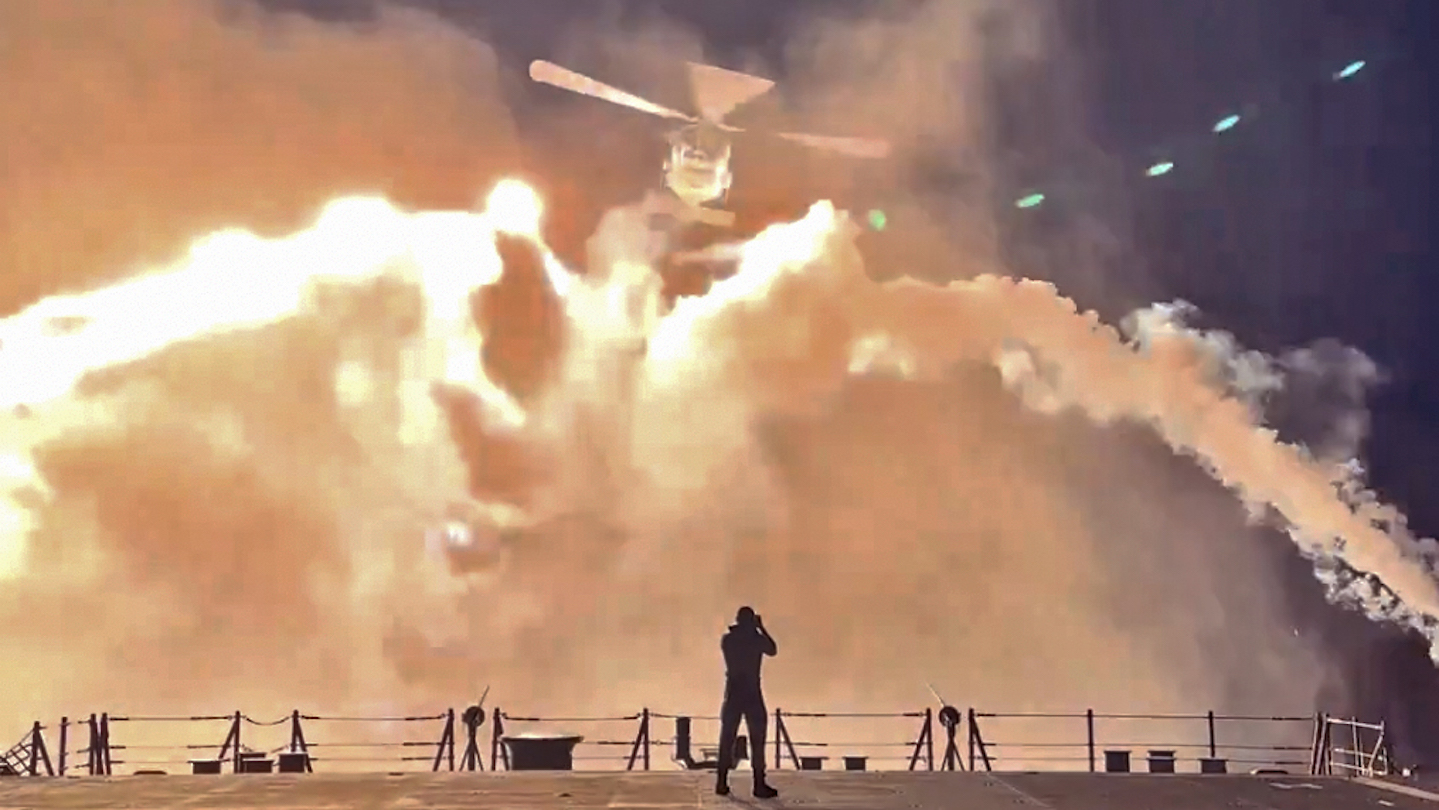It’s the turn of the Royal Australian Navy to provide us with a spectacular view of airborne infrared countermeasures in action, with a recent video showing a demonstration by one of its MH-60R Seahawk multi-mission maritime helicopters. In the past, TWZ has examined some remarkable air-launched countermeasures action, including extreme close-ups, mass drops, airshow routines, and flare ‘dumps’ from Soviet-era heavyweight transports. This may be the first time we’ve seen a helicopter perform this kind of pyrotechnical feat close behind a warship.
The video shows Leading Seaman Imagery Specialist Daniel Goodman of the Royal Australian Navy (RAN) as he takes photos of the MH-60R that is hovering off the stern of the Hobart class destroyer HMAS Sydney. The Seahawk, better known as a “Romeo,” is embarked on the warship as “Phoenix” Flight.
It seems the photos that Goodman took from his position right at the far end of the destroyer’s flight deck have not yet been publicly released. In the meantime, however, the video, which appears to have been taken from just in front of the warship’s helicopter hangar, at the opposite end of the flight deck, is extraordinary in itself.
Over a period of around 10 seconds, the hovering helicopter spits out dozens of infrared countermeasures cartridges which make for a real spectacle as they cascade down from either side of the aircraft. As well as palls of smoke, the glare from the flares illuminates the flight deck, while the extreme contrast turns the sky almost black.

The presence of a photographer so close to the action — and the release of such a considerable quantity of flares — suggests this may have been primarily a media opportunity, but again, we don’t know for sure and have asked the RAN for more details (and imagery).
The date and location of the video are also unclear, although Goodman also recently recorded HMAS Sydney as it took part in major multinational maneuvers as a component of a multinational task group in the Indo-Pacific region. Also involved were the French Navy frigate Bretagne, German Navy frigate Baden-Württemberg and replenishment ship Frankfurt am Main, Italian Navy frigates Cavour and Alpino, and patrol ship Montecuccoli, and the Japan Maritime Self-Defense Force’s helicopter carrier Izumo and destroyer Onami.
The MH-60R is the workhorse of the RAN’s rotary-wing fleet, with a total of 36 examples having been ordered. Commissioned into service in 2014, these aircraft serve with two operational and one training squadron and deploy aboard various warships, flying missions including anti-submarine warfare, anti-surface warfare, vertical replenishment, passenger and cargo transfer, and search and rescue.

As we have discussed before, countermeasures flares of the kind seen in the video from HMAS Sydney are a key tool in the aviator’s box of self-defense tricks. Burning at thousands of degrees, they are especially valuable to helicopters (as well as low-flying ground-attack aircraft) that spend much of their missions operating in high-risk areas of their flight envelope and in environments where shoulder-launched surface-to-air missiles are a likely hazard.
We have also explored in the past the different ways that countermeasures flares can be deployed, with three primary modes available depending on the nature of the threat. The first mode is fully automatic, with the dispenser system responding to threat data from the missile approach warning system and responding without aircrew input. The second is semi-automatic, with the dispenser system selecting the best response, signaling that to the aircrew, who then initiate the release. Finally, in manual mode, the aircrew select a pre-programmed response, in terms of quantities, sequences, and types of expendables to be employed.
The cost of infrared countermeasures is highly variable and something that you can read more about here.
Manual mode would have been used in the MH-60R video, to ensure these eye-catching results. This kind of photo opportunity is something that the RAN has exploited in the past, too.
The photo below, dating from 2020, shows an MH-60R embarked on the Anzac class frigate HMAS Parramatta as it releases flares during a training flight while on deployment in Southeast Asia.

Another image shows the MH-60R embarked on the destroyer HMAS Hobart as it fires flares off the coast of New South Wales. The photo is just as dramatic but has also been digitally altered, according to the Australian Department of Defense.

Similar photo opportunities have been provided in the past by the MH-60R’s predeccessor in RAN service, the S-70B-2 Seahawk. In this example, the S-70B-2 embarked on HMAS Melbourne was deploying flares off the stern in celebration of its having achieved 5,000 flying hours while on patrol in the Middle East area of operations.

While these are all impressive in their own way, they are eclipsed by the dynamism of the video taken from HMAS Sydney, especially bearing in mind the helicopter’s (and the pyrotechnics’) proximity to the warship and the photographer on the flight deck.
As well as being vital for survival in many different combat theaters, and requiring periodic training and testing, infrared flares are also a very impressive visual ‘trick’ that can be called upon by aviators who have them at their disposal. Two reasons why we’re likely to see similar displays of pyrotechnics by RAN Seahawks and other types in the future.
Contact the author: thomas@thewarzone.com
